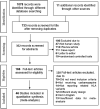Associations of HLA genetic variants with carbamazepine-induced cutaneous adverse drug reactions: An updated meta-analysis
- PMID: 35599240
- PMCID: PMC9372413
- DOI: 10.1111/cts.13291
Associations of HLA genetic variants with carbamazepine-induced cutaneous adverse drug reactions: An updated meta-analysis
Abstract
Aggregated risk of carbamazepine (CBZ)-induced cutaneous adverse drug reactions (cADRs) with different HLA variants are unclear and limited in terms of the power of studies. This study aimed to assess the aggregated risk of CBZ-induced cADRs associated with carrying the following HLA variants: HLA-B*15:02, HLA-B*15:11, HLA-B*15:21, HLA-B*38:02, HLA-B*40:01, HLA-B*46:01, HLA-B*58:01, HLA-A*24:02, and HLA-A*31:01. Literature was searched in different databases following PRISMA guidelines. The outcomes were measured as odds ratio (OR) using RevMan software by a random/fixed effects model, where p < 0.05 was set as statistical significance. In total, 46 case-control studies met the inclusion criteria and were included in this analysis consisting of 1817 cases and 6614 controls. It was found that case-patients who carried the HLA-B*15:02 allele were associated with a significantly increased risk of CBZ-induced Stevens-Johnson syndrome/toxic epidermal necrolysis (SJS/TEN) compared to controls (OR 26.01; 95% CI 15.88-42.60; p < 0.00001). The aggregated risk of cADRs was slightly higher in Asian compared to Caucasian patients (Asians: OR 14.84; 95% CI 8.95-24.61; p < 0.00001; Caucasians: OR 11.65; 95% CI 1.68-80.70; p = 0.01). Further, HLA-B*15:11, HLA-B*15:21, or HLA-A*31:01 allele was also associated with significantly increased risk of CBZ-induced cADRs (HLA-B*15:11: OR 6.08; 95% CI 2.28-16.23; p = 0.0003; HLA-B*15:21: OR 5.37; 95% CI 2.02-14.28; p = 0.0008; HLA-A*31:01: OR 5.92; 95% CI 4.35-8.05; p < 0.00001). Other HLA variants were not found to have any significant associations with CBZ-induced cADRs. Strong associations between the HLA-B*15:02, HLA-B*15:11, HLA-B*15:21, or HLA-A*31:01 allele with CBZ-induced cADRs have been established in this analysis. Pharmacogenetic testing of particular HLA alleles before initiation of CBZ therapy may be beneficial to patients and may help to eradicate cADRs substantially.
© 2022 The Authors. Clinical and Translational Science published by Wiley Periodicals LLC on behalf of American Society for Clinical Pharmacology and Therapeutics.
Conflict of interest statement
The authors declared no competing interests for this work.
Figures






Similar articles
-
Genome-wide association study identifies HLA-A*3101 allele as a genetic risk factor for carbamazepine-induced cutaneous adverse drug reactions in Japanese population.Hum Mol Genet. 2011 Mar 1;20(5):1034-41. doi: 10.1093/hmg/ddq537. Epub 2010 Dec 10. Hum Mol Genet. 2011. PMID: 21149285
-
Risk and association of HLA with oxcarbazepine-induced cutaneous adverse reactions in Asians.Neurology. 2017 Jan 3;88(1):78-86. doi: 10.1212/WNL.0000000000003453. Epub 2016 Dec 2. Neurology. 2017. PMID: 27913699
-
HLA alleles and hypersensitivity to carbamazepine: an updated systematic review with meta-analysis.Pharmacogenet Genomics. 2014 Feb;24(2):94-112. doi: 10.1097/FPC.0000000000000021. Pharmacogenet Genomics. 2014. PMID: 24336023
-
Genetic susceptibility to carbamazepine-induced cutaneous adverse drug reactions.Pharmacogenet Genomics. 2006 Apr;16(4):297-306. doi: 10.1097/01.fpc.0000199500.46842.4a. Pharmacogenet Genomics. 2006. PMID: 16538176
-
Association between the HLA-B alleles and carbamazepine-induced SJS/TEN: A meta-analysis.Epilepsy Res. 2017 Sep;135:19-28. doi: 10.1016/j.eplepsyres.2017.05.015. Epub 2017 Jun 3. Epilepsy Res. 2017. PMID: 28618376 Review.
Cited by
-
Pharmacogenomics and non-genetic factors affecting drug response in autism spectrum disorder in Thai and other populations: current evidence and future implications.Front Pharmacol. 2024 Feb 5;14:1285967. doi: 10.3389/fphar.2023.1285967. eCollection 2023. Front Pharmacol. 2024. PMID: 38375208 Free PMC article. Review.
-
Pre- and Post-Exposure Prophylaxis for HIV in Patients Taking Anti-Seizure Medications.Epilepsy Curr. 2024 May 28;24(4):219-231. doi: 10.1177/15357597241253500. eCollection 2024 Jul-Aug. Epilepsy Curr. 2024. PMID: 39309052 Free PMC article. Review.
-
Assessment of clinically actionable pharmacogenetic markers to stratify anti-seizure medications.Pharmacogenomics J. 2023 Nov;23(6):149-160. doi: 10.1038/s41397-023-00313-y. Epub 2023 Aug 26. Pharmacogenomics J. 2023. PMID: 37626111
-
Lamotrigine Therapy: Relation Between Treatment of Bipolar Affective Disorder and Incidence of Stevens-Johnson Syndrome-A Narrative Review of the Existing Literature.J Clin Med. 2025 Jun 10;14(12):4103. doi: 10.3390/jcm14124103. J Clin Med. 2025. PMID: 40565849 Free PMC article. Review.
-
Polygenic risk scores: An overview from bench to bedside for personalised medicine.Front Genet. 2022 Nov 11;13:1000667. doi: 10.3389/fgene.2022.1000667. eCollection 2022. Front Genet. 2022. PMID: 36437929 Free PMC article. Review.
References
REFERENCES OF STUDIES INCLUDED FOR META‐ANALYSIS
Publication types
MeSH terms
Substances
LinkOut - more resources
Full Text Sources
Research Materials
Miscellaneous

